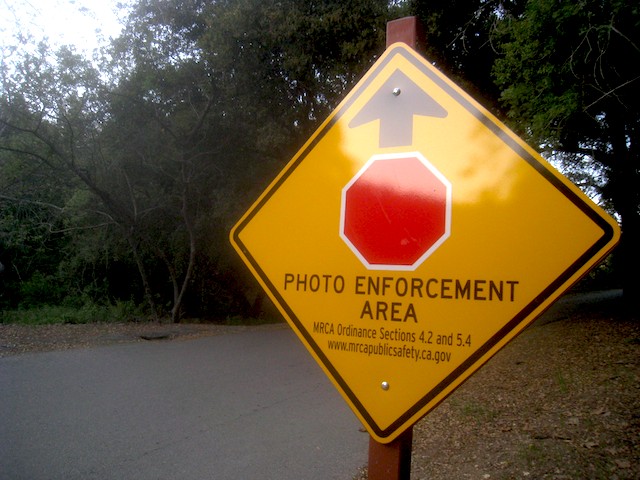Mountains Recreation & Conservation Authority Responds to LAT Article on Stop Sign Cameras
7:42 AM PDT on August 24, 2011

On Monday, the Los Angeles Times printed an eye-rolling article about the use of stop sign cameras to enforce safe street laws in the state parks surrounding the Santa Monica Mountains. In response, the Mountains Recreation & Conservation Authority's executive director, Joseph T. Edmiston wrote the following letter to the staff and board of the Authority. It's an instructive read, especially if the traffic scofflaw community decides this is their next battleground.
One of Edmiston's main points is most interesting. The cameras are set to only record people blowing through the signs, someone making a "rolling stop" wouldn't be ticketed based on the cameras settings.
So the people complaining in the Times article are really complaining that they're really bad drivers. - DN
Dear all,
Two things to report:
1. On the good news side, Friday we got notice that the Appellate Division certified for publication the decision in MRCA vs. Kaufman. That means this decision UPHOLDING ALL ASPECTS OF THE PROGRAM is binding precedent for the Los Angeles County Superior Court. Attached is a copy of the opinion. (We got a copy of the decision and posted it here. - DN)
2. On the other hand, the Los Angeles Times this morning had this really one-sided story. What the Times felt was newsworthy was violators getting angry when they are videoed blowing through stop signs (and who isn’t miffed at getting caught).
My favorite quote in this story is the guy who takes umbrage at getting 8 violations before he noticed the program. How about noticing the stop sign buddy?
This is a good opportunity to recap the program and the rationale for it.
First of all, for those who think the California rolling-stop is a basic civil right, we aren’t impinging thereon. The cameras are set so they don’t record anything under a certain speed. (For obvious reasons I can’t reveal that speed outside of closed session, but it is well below what most people would consider a good faith effort to “stop.”) Issuing a citation isn’t automatic. The citation is issued on an individual basis by a specially trained park ranger who is also a California peace officer. The standard is: If it were your eyes instead of the camera, would you have issued the citation? Ambiguities are resolved in favor of the driver. Moreover, there are no improper incentives. The camera company gets a fixed monthly fee, irrespective of the number of violations, and the park rangers are paid from an entirely separate fund.
It is worth remembering why the program was started in the first place. Neither of the two major areas with video enforcement was ever intended to be a public park. Temescal was a private church camp and Franklin was an L.A. Water and Power reservoir with public access prohibited. If these parks were to be constructed from scratch the layout would be much different—wider roads, better circulation pattern, separation of pedestrians from cars, etc. But that’s not an option now. The environmental damage of such an infrastructure retrofit would be too great, say nothing of public objection to “urbanizing” these rural retreats.
Temescal is a good example: In the mid-1980’s when the plan for Temescal Gateway Park was being considered one of the options called for realigning the road system and bringing it up to design standard for the volume of expected park visitation. There was unanimity within the Pacific Palisades community that a modern road system would destroy the very values for which the land was purchased. Some years later when the city realigned and improved the Sunset Blvd/Temescal Canyon Rd intersection, the local input committee that the Conservancy established, known as the Temescal Working Group, insisted that we promise not to use the city’s improvements as an “excuse” to widen the road! The two stop signs are only placed at intersections where there is cross traffic, hikers vs. cars. Each stop sign location has been validated by a professional traffic engineer.
Franklin Canyon is even worse of a problem. Up until the city of Los Angeles closed it to through traffic, Franklin Canyon Drive was one of the familiar cross mountain roads, a well known cut-off when Coldwater Canyon was jammed. However, the city’s closure didn’t stop the traffic, now the commuters just use the old private reservoir maintenance road which also serves as the internal park access way. Most all of you have been to Franklin Canyon, you know the physical impossibility of widening Lake Drive around the upper reservoir, you also know the practical impossibility of segregating cars belonging to park visitors from commuters, so we are forced to tolerate non-park traffic. Just like at Temescal, the photo enforced stop signs are placed only at points of significant cross traffic and each have been validated by the traffic engineer.
Video enforcement is working. Violations are down over 50% from pre-video levels. (We know this because the cameras ran for a baseline period before enforcement was initiated.) Given that we can’t have a park ranger assigned to each stop sign—there aren’t enough of them and they have other important duties—the video enforcement program is the next best thing for reducing agency liability and ensuring public safety.
To those scofflaw defenders who say we are “over-enforcing” because we haven’t had a traffic fatality, my only reply is “exactly.”
Stay in touch
Sign up for our free newsletter
More from Streetsblog Los Angeles
Metro Board Funds Free Student Transit Pass Program through July 2025
Metro student free passes funded another year - plus other updates from today's Metro board meeting
Eyes on the Street: New Lincoln Park Avenue Bike Lanes
The recently installed 1.25-mile long bikeway spans Lincoln Park Avenue, Flora Avenue, and Sierra Street - it's arguably the first new bike facility of the Measure HLA era




